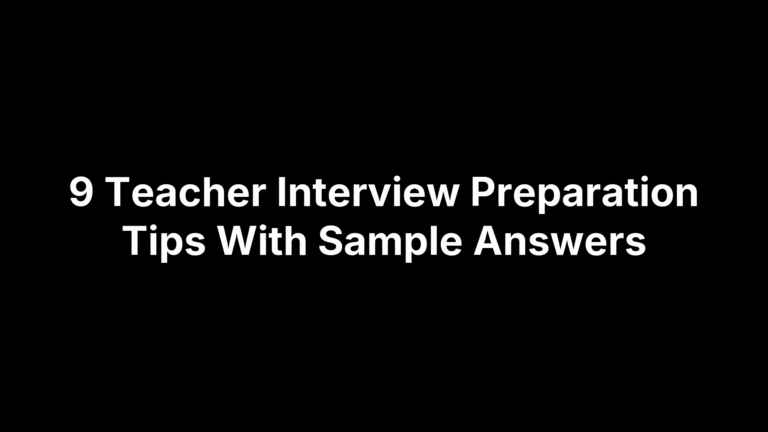Top 10 Teacher Interview Questions and How to Answer Them
Below you’ll find a comprehensive guide designed to assist teachers in navigating the most commonly asked teacher interview questions. This article offers valuable insights into how to answer interview questions about areas such as effective classroom management, engaging with parents and the school community, integrating technology in education, and setting professional development goals. Aimed at educators at various stages in their careers, it provides practical strategies and expert tips to improve your answers to tricky interview questions.
Can you tell us about yourself and why you chose teaching as a career?
This question aims to understand your motivation for being in the education field and your personal background. When answering this question, it’s important to provide a personal and professional response. Here are some key points to consider when crafting your answer:
Start with Your Background: Briefly mention where you’re from and your educational background. Highlight any relevant degrees, certifications, or training you have received that have prepared you for a career in teaching.
Share Your Passion for Teaching: Talk about what drew you to the field of education. This could be a lifelong love for learning, a desire to make a difference, a particular teacher who inspired you, or a realization that teaching is where your strengths lie.
Discuss Your Teaching Philosophy: Explain your beliefs about teaching and learning. What do you think is the most important aspect of teaching? How do you see your role as an educator? This helps the interviewer understand your approach to the profession.
Highlight Relevant Experiences: If you have prior teaching experience, discuss what you learned from it and how it has shaped you as a teacher. If you’re new to teaching, you can mention any relevant experiences such as tutoring, mentoring, or even experiences outside of education that have equipped you with skills useful in a classroom.
Connect with the School’s Values: If you know specific things about the school or district where you’re interviewing, try to connect your reasons for choosing teaching with their values or mission statement. This shows that you’ve done your research and are genuinely interested in being a part of their team.
Conclude with Your Future Goals: Briefly mention your career aspirations. How do you hope to grow as a professional? What impact do you want to have on your students and the school community?
Remember, while it’s important to be professional, don’t be afraid to show your genuine enthusiasm and passion for teaching. The goal is to give the interview panel a sense of who you are as an individual and as an educator.
How would you describe your teaching philosophy?
Interviewers want to know if your educational beliefs align with their school’s approach and how you envision your role as a teacher. When responding to the question, it’s important to clearly articulate your beliefs about education and how they inform your approach to teaching. Here are some tips on structuring your response:
Start with Your Core Beliefs: Begin by stating the fundamental beliefs that drive your approach to teaching. This could be a commitment to fostering a love of learning, the belief that all students can succeed, or the importance of a student-centered classroom.
Explain Your Approach to Learning: Discuss how your beliefs translate into your teaching methods. For instance, if you believe in a student-centered approach, you might talk about how you use collaborative projects or inquiry-based learning to engage students.
Describe How You Engage Students: Mention specific strategies you use to make learning engaging and accessible for all students. This could include differentiated instruction, incorporating technology, or using real-world examples to make content relevant.
Discuss Classroom Environment: Share how your philosophy influences the type of environment you strive to create in your classroom. Do you prioritize a safe and inclusive atmosphere where students feel comfortable taking risks and expressing themselves?
Include Assessment Methods: Explain how you believe assessments should be conducted. Do you prefer formative assessments that guide your teaching and provide ongoing feedback, or do you focus on summative assessments to measure student understanding at the end of a unit?
Reflect on Teacher-Student Relationships: Discuss the role you believe a teacher should play in a student’s life. Are you a facilitator, a mentor, an advocate? How do you build and maintain relationships with your students?
Align with the School’s Philosophy: If you’re aware of the school’s teaching philosophy, draw connections between your beliefs and theirs. This shows that you are not only a good fit for the role but also that you are knowledgeable and have done your research about the school.
Conclude with Continuous Learning: Mention your commitment to professional growth and staying abreast of educational research and best practices. This demonstrates that your philosophy isn’t static but evolves with your ongoing learning and experiences.
Remember, the goal is to convey that your teaching philosophy isn’t just a set of ideals, but a practical and integral part of how you teach every day. Be sincere and ensure your response reflects your true approach to education.
What is your approach to classroom management?

Schools are interested in how you maintain a productive and respectful learning environment. When responding to the question, convey a balanced, proactive strategy that emphasizes creating and maintaining a positive, respectful learning environment. Here’s a structured approach to crafting your response:
Philosophy of Classroom Management: Begin by outlining your core beliefs about classroom management. Emphasize the importance of a positive, engaging, and inclusive classroom environment where respect and mutual understanding are paramount.
Establishing a Positive Classroom Culture: Describe how you establish a positive classroom culture from the outset. This might involve setting clear expectations, involving students in creating classroom norms, and building a sense of community.
Proactive Strategies: Discuss your proactive strategies to prevent disruptions, such as engaging and differentiated lesson plans, clear instructions, and regular check-ins with students. Highlight how these strategies minimize the need for reactive discipline.
Consistency and Fairness: Stress the importance of consistency and fairness in applying classroom rules and consequences. Explain how you ensure all students understand the expectations and the reasons behind them.
Building Relationships: Highlight your commitment to building strong relationships with your students. Mention how understanding their individual backgrounds, interests, and challenges can help you manage the classroom more effectively.
Responsive Techniques: Share your techniques for responding to challenging behaviors when they occur. This could include restorative practices, private discussions, or modifying classroom arrangements and routines to better suit student needs.
Communication with Parents and Caregivers: Mention the role of effective communication with parents and caregivers in managing classroom behavior. Describe how you keep them informed and involved in their child’s progress and behavior strategies.
Reflection and Adaptation: Discuss how you regularly reflect on and adapt your classroom management strategies. Mention how you stay informed about the latest research and best practices in classroom management and are open to changing your approach based on what works best for your students.
Focus on Learning and Growth: Conclude by emphasizing that your primary goal in classroom management is to create an environment conducive to learning and growth. Stress that managing a classroom effectively means fostering a space where all students feel safe, respected, and motivated to learn.
Incorporating specific examples from your experience can greatly enhance your response, providing a clear illustration of how you apply these strategies in a real classroom setting.
How do you differentiate instruction to meet the needs of all learners?
This question assesses your ability to adapt lessons to accommodate students with varying abilities and learning styles. Provide a well-rounded view that illustrates your ability to maintain a productive, respectful, and inclusive learning environment. Here are some points to consider when structuring your response:
Understanding of Differentiation: Start by briefly explaining what differentiated instruction means to you. Emphasize its importance in catering to diverse learning styles, abilities, and interests within the classroom.
Assessment of Student Needs: Describe how you assess the individual needs of your students. This could involve a mix of formal and informal assessments, observations, and discussions to understand their strengths, weaknesses, and learning preferences.
Flexible Grouping: Discuss how you use flexible grouping in your classroom. This might include varying groups for different activities based on ability, interest, or learning style to ensure that all students are appropriately challenged and supported.
Varied Instructional Strategies: Explain how you employ a variety of teaching methods to address different learning styles. This could include lectures, hands-on activities, collaborative work, multimedia resources, and independent study.
Adapting Learning Materials: Share examples of how you modify learning materials and resources. This could be through the use of leveled reading materials, visual aids, or interactive technology to make content accessible to all students.
Pacing and Scaffolding: Talk about how you adjust the pace of instruction and provide scaffolding to support learners. This involves breaking down complex tasks into smaller, manageable steps for students who need more time or support.
Individualized Learning Plans: If applicable, mention your experience with creating or following Individualized Education Plans (IEPs) or 504 Plans for students with special education needs.
Encouraging Student Autonomy: Highlight how you encourage self-directed learning by offering choices in assignments or projects, allowing students to explore areas of interest or to demonstrate their understanding in different ways.
Collaboration with Colleagues: Discuss how you collaborate with other teachers, special education staff, or language support staff to design and implement differentiated instruction strategies.
Reflective Practice and Professional Development: Conclude by mentioning your commitment to ongoing learning and adaptation in your teaching practice. This could include professional development courses, workshops, or research on the latest strategies in differentiated instruction.
In your response, it’s beneficial to provide specific examples or anecdotes from your teaching experience that illustrate how you’ve effectively implemented differentiated instruction. This will help to demonstrate your practical application of these strategies in a real-world setting.
Can you give an example of a successful lesson you have taught and why it was successful?
When responding to the question, “Can you give an example of a successful lesson you have taught and why it was successful?” it’s crucial to choose an example that showcases your teaching skills, creativity, and ability to engage students effectively. Here’s a structured approach to crafting your response:
Select a Specific Lesson: Choose a lesson that was particularly successful and resonates with your teaching style. This could be a lesson where students achieved significant learning outcomes, displayed high engagement, or demonstrated creative thinking.
Describe the Lesson Context: Provide context for the lesson. What was the subject and topic? What were the learning objectives? Briefly outline the age and dynamics of the class, as this sets the stage for understanding the lesson’s impact.
Explain the Teaching Methods Used: Detail the teaching methods and instructional strategies you employed. Did you use project-based learning, group discussions, hands-on activities, or technology integration? Explain why you chose these methods for this particular lesson.
Illustrate Student Engagement and Participation: Describe how the students engaged with the lesson. Mention any activities that particularly captured their interest or facilitated active participation. This can include group work, interactive elements, or problem-solving exercises.
Discuss Assessment and Outcomes: Explain how you assessed the students’ learning and the outcomes of the lesson. What evidence did you see of student understanding or skill development? This could be through formal assessments, student feedback, or observable changes in understanding and engagement.
Reflect on Why It Was Successful: Analyze why the lesson was successful. Was it the alignment of the lesson with student interests, the effectiveness of your teaching methods, or the way you adapted to student needs? Discuss how this lesson reflected your strengths as a teacher.
Incorporate Student Feedback or Reactions: If you received any direct feedback from students about the lesson, include this in your explanation. Student reactions can provide a compelling testament to the lesson’s success.
Connect to Broader Teaching Goals: Link this successful lesson to your broader teaching goals and philosophy. How does this lesson exemplify your approach to teaching and commitment to student success?
Consider Lessons Learned and Future Applications: Conclude by mentioning what you learned from this experience and how it has influenced your future teaching. Discuss any adjustments or enhancements you would make when conducting a similar lesson in the future.
Providing a concrete example with detailed explanations will not only demonstrate your teaching effectiveness but also give the interviewer insight into your approach to curriculum planning, classroom engagement, and reflective practice.
How do you assess and evaluate students’ learning?

Understanding your approach to assessment gives insight into how you measure student progress and provide feedback. It’s important to demonstrate a comprehensive and thoughtful approach to assessment that supports student growth. Here are key points to consider in your response:
Balanced Approach to Assessment: Start by explaining that you use a mix of formative and summative assessments. Formative assessments (like quizzes, class discussions, and informal observations) help you monitor student learning and provide ongoing feedback, while summative assessments (like tests, final projects, or presentations) evaluate student learning at the end of an instructional period.
Alignment with Learning Objectives: Emphasize that your assessments are directly aligned with your learning objectives. Explain how you ensure that what you’re assessing is what you intended to teach.
Variety of Assessment Methods: Discuss the different types of assessments you use to cater to various learning styles. This might include written tests, oral presentations, group projects, portfolios, or peer assessments.
Use of Rubrics and Clear Criteria: Mention how you use rubrics or set clear criteria for assessments to ensure that grading is fair, transparent, and consistent.
Feedback for Growth: Highlight the importance of providing timely and constructive feedback that guides students on how to improve. Explain how you make your feedback actionable and specific.
Student Self-Assessment and Reflection: Talk about the role of self-assessment in your classroom. Encourage students to reflect on their own work and learning processes, which promotes self-awareness and responsibility for their learning.
Incorporating Technology: If you use technology in assessment, mention tools like educational software, online quizzes, or digital portfolios, and how they enhance the assessment process.
Adaptations for Diverse Learners: Discuss how you adapt your assessments for students with different needs, such as language learners or students with special educational needs. This could involve alternative formats, extended time, or tailored assignments.
Use of Data to Inform Instruction: Explain how you use assessment data to inform your teaching. Discuss how this data helps you identify areas where students are struggling and how you adjust your instruction in response.
Continuous Improvement: Conclude by mentioning your commitment to continuous improvement in your assessment practices, staying updated with educational research, and being open to new and effective methods of evaluating student learning.
Incorporate specific examples or experiences that demonstrate your assessment practices in action. This not only adds credibility to your response but also gives the interviewer a clear picture of how you implement these strategies in the classroom.
How do you integrate technology into your teaching?
With the growing importance of technology in education, schools want to know how you utilize it to enhance learning. When addressing the question, demonstrate your understanding of the role of technology in enhancing learning experiences and outcomes. Here’s how you might structure your response:
Philosophy on Technology in Education: Begin by expressing your beliefs about the role of technology in education. Emphasize that technology is a tool to enhance learning, not a replacement for effective teaching.
Use of Educational Software and Online Resources: Discuss how you incorporate educational software and online resources into your lessons. Mention specific platforms or tools you have used, such as learning management systems (LMS), educational games, or interactive simulations, and how they contribute to student engagement and understanding.
Blended Learning Approaches: Explain how you use technology to facilitate blended learning. This might involve a combination of face-to-face instruction with online resources, encouraging students to explore concepts at their own pace.
Interactive and Collaborative Tools: Highlight your use of interactive tools like digital whiteboards, online discussion forums, or collaborative platforms (like Google Classroom) that promote student interaction and collaboration.
Differentiation and Personalized Learning: Discuss how technology enables you to differentiate instruction and provide personalized learning experiences. Examples might include adaptive learning software, educational apps that cater to different learning styles, or providing materials at varying reading levels.
Digital Literacy and Citizenship: Mention how you teach digital literacy and responsible online behavior. This includes educating students on internet safety, ethical use of digital content, and understanding digital footprints.
Incorporating Multimedia and Digital Content: Talk about how you use multimedia elements like videos, podcasts, and slideshows to make lessons more engaging and cater to different learning modalities.
Assessment and Feedback: Explain how you use technology for assessments and providing feedback. This could involve online quizzes, digital portfolios, or tools that allow for immediate feedback.
Professional Development and Continuous Learning: Share your commitment to staying updated with the latest technological tools and educational practices. Mention any professional development courses, workshops, or conferences you’ve attended related to educational technology.
Reflect on the Challenges and Adaptations: Acknowledge the challenges of integrating technology, such as ensuring equitable access and adapting to different technological resources. Discuss how you’ve navigated these challenges or adapted your methods to different classroom settings.
Remember to provide specific examples from your teaching experience to illustrate how you’ve effectively integrated technology. This not only adds depth to your answer but also demonstrates your practical skills and adaptability in using technology in education.
How do you handle conflicts or challenging behavior in the classroom?
This question is about your problem-solving skills and ability to maintain a positive learning environment. When answering this question, it’s crucial to demonstrate your problem-solving skills and commitment to maintaining a positive learning environment. Here’s how to structure your response:
Proactive Approach: Begin by emphasizing the importance of a proactive approach to prevent conflicts and challenging behaviors. Mention strategies like establishing clear expectations, creating a respectful classroom culture, and engaging lesson plans to minimize disruptions.
Understanding Root Causes: Explain how you strive to understand the root causes of conflicts or challenging behaviors. Discuss the importance of knowing your students well and considering factors like background, emotional state, and individual needs that might influence their behavior.
Empathy and Active Listening: Highlight your use of empathy and active listening in conflict resolution. Demonstrate how you give students a chance to express their feelings and viewpoints, showing that you value their perspective.
Consistency in Enforcing Rules: Discuss how you apply classroom rules consistently and fairly. Explain how you have clear, predetermined consequences for misbehavior and how you communicate these to your students.
Use of Positive Reinforcement: Mention how you use positive reinforcement to encourage good behavior. Examples might include praise, rewards, or positive attention for adhering to classroom norms.
Conflict Resolution Techniques: Share specific techniques you use for resolving conflicts, such as mediation, guided discussions, or restorative practices. Show that you focus on solutions that promote understanding and reconciliation.
Collaboration with Colleagues and Parents: Talk about how you collaborate with colleagues, counselors, and parents when handling challenging behaviors. This could include seeking advice, sharing strategies, or involving parents in behavior management plans.
Adapting Strategies to Individual Needs: Explain how you tailor your approach to suit the needs of individual students, especially those with special educational needs or behavioral plans.
Reflection and Professional Development: Discuss how you reflect on and assess the effectiveness of your behavior management strategies. Mention any professional development or training you have undertaken in this area.
Maintaining a Positive Environment: Conclude by reiterating your commitment to maintaining a positive, inclusive, and safe learning environment for all students. Stress that handling conflicts and challenging behavior is an opportunity for learning and growth, not just for students, but also for you as an educator.
Incorporate specific examples or anecdotes from your teaching experience to illustrate your approaches in action. This adds credibility to your response and gives the interviewer a clear picture of your practical skills in managing classroom behavior.
How do you engage with parents and the school community?

Schools look for teachers who can effectively communicate and collaborate with parents and community members. Highlight your communication skills and your commitment to building strong, collaborative relationships. Here’s a suggested structure for your response:
Communication Philosophy: Start by expressing your belief in the importance of open, ongoing communication with parents and the broader school community. Emphasize that this partnership is crucial for supporting student success.
Regular Updates and Information Sharing: Describe how you keep parents informed about their child’s progress, classroom activities, and any upcoming events. This might involve newsletters, emails, class websites, or apps designed for parent-teacher communication.
Parent-Teacher Conferences: Talk about your approach to parent-teacher conferences, emphasizing active listening, sharing insights about the student’s performance, and discussing strategies for supporting their learning at home.
Accessibility and Open Door Policy: Mention your commitment to being accessible to parents for concerns and questions, whether through scheduled meetings, phone calls, or email correspondence.
Involving Parents in Learning: Discuss ways you involve parents in the educational process, such as inviting them to participate in class activities, projects, or as guest speakers, which can enhance the learning experience and create a sense of community.
Community Engagement Activities: Share any initiatives or activities you’ve been involved in or led that engage the wider school community, like organizing school events, participating in local projects, or collaborating with community organizations.
Cultural Sensitivity and Inclusivity: Highlight your sensitivity to the diverse backgrounds of students and their families. Discuss how you ensure that communication is inclusive and respectful of different cultures and languages.
Feedback and Collaboration: Explain how you encourage and value feedback from parents and community members, viewing it as an opportunity for collaboration and improvement.
Use of Technology: If applicable, mention how you leverage technology to enhance engagement, like virtual meetings, social media, or other online platforms.
Professional Development and Growth: Conclude by mentioning any professional development you’ve undertaken related to community engagement, or your willingness to learn and adapt your strategies to better connect with parents and the community.
In your response, be sure to provide specific examples or experiences that demonstrate your effective engagement with parents and the school community. This not only reinforces your answer but also showcases your practical skills in fostering a collaborative and supportive educational environment.
What are your professional development goals?
This question aims to gauge your commitment to continual learning and growth in the education field. When responding, demonstrate your commitment to continuous learning and growth as an educator. Here’s a structured approach to formulating your answer:
Lifelong Learning Philosophy: Begin by expressing your belief in the importance of lifelong learning for educators. Emphasize that staying current and continuously improving is crucial in the ever-evolving field of education.
Specific Short-Term Goals: Discuss your immediate or short-term professional development goals. This could include attending specific workshops, learning new teaching methods, incorporating technology more effectively in the classroom, or improving in areas like classroom management or assessment strategies.
Long-Term Aspirations: Share your long-term career aspirations. These might involve pursuing advanced degrees, obtaining additional certifications, transitioning into educational leadership roles, or specializing in areas like special education, educational technology, or curriculum development.
Staying Updated with Educational Trends: Mention your intention to stay informed about the latest trends and research in education. This could involve subscribing to educational journals, participating in online forums, or being part of professional educator networks.
Improving Student Learning Outcomes: Explain how your professional development goals align with improving student learning outcomes. Discuss how your growth as an educator directly benefits your students.
Peer Collaboration and Mentoring: Talk about your interest in collaborative learning and peer mentoring. This might include participating in or leading professional learning communities within your school or district.
Technology Integration: If technology is a significant aspect of modern education, discuss how you plan to enhance your skills in this area, whether it’s using new educational software, integrating digital tools into the classroom, or understanding data analytics in education.
Diversity and Inclusion Training: Highlight any goals related to understanding and promoting diversity, equity, and inclusion within the educational setting. This is increasingly important in creating supportive environments for all students.
Personal Growth: Mention how these professional development goals also contribute to your personal growth, shaping you into a more effective, empathetic, and knowledgeable educator.
Continuous Reflection and Adaptation: Conclude by emphasizing your commitment to continuously reflecting on your practice and adapting your professional development goals as your career progresses and as the needs of your students evolve.
Remember, providing specific and actionable goals shows that you have a clear direction for your professional growth. It’s also beneficial to align these goals with the needs and objectives of the school or district you are interviewing with, demonstrating your fit within their educational framework.
Conclusion
In conclusion, navigating a teacher interview requires a blend of self-awareness, preparation, and a deep understanding of the teaching profession. The questions discussed in this article, “Top 10 Teacher Interview Questions and How to Answer Them,” are designed to probe your teaching philosophy, classroom management skills, approach to student assessment and differentiation, as well as your ability to integrate technology and engage with the school community. Remember, each question is an opportunity to showcase your passion for teaching, your commitment to student success, and your readiness to contribute to the school’s culture. By thoughtfully preparing your responses and reflecting on your experiences and goals, you demonstrate not just your qualifications, but also your dedication to the noble profession of teaching. Go into your next interview armed with these insights, confident in your ability to articulate your vision and value as an educator, and ready to embark on the next exciting chapter of your teaching career.






